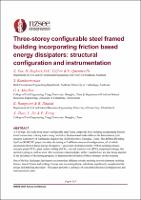Three-storey Configurable Steel Framed Building Incorporating Friction Based Energy Dissipaters: Structural Configuration and Instrumentation

Download
Date
2021-04-14Authors
Yan, Zhenduo
Bagheri, Hamed
Ramhormozian, Shahab
Clifton, Charles
Rangwani, Kiran
MacRae, Gregory
Quenneville, Pierre
Rodgers, Geoffrey
Xiang, Ping
Jia, Liang-Jiu
Zhao, Xianzhong
Metadata
Show full item recordAbstract
A 9 m high, full-scale three-storey configurable steel frame composite floor building incorporating friction based connections is being tested using two linked bi-directional shake tables at the International joint research Laboratory of Earthquake Engineering (ILEE) facilities, Shanghai, China. This RObust BUilding SysTem (ROBUST) project includes the testing of 9 different structural configurations, all of which incorporate friction-based energy dissipaters. Typical non-skeletal elements (NSEs) including precast-concrete panel (PCP), glass curtain walling (GCW), internal partition wall (IPW), suspended ceilings, fire sprinkler piping as well as some other common contents (desks/ tables/ bookshelves) are also being adopted in the last phase of the testing program, to determine the influence of these elements on the response.
One of the key challenges has been to accommodate different seismic resisting systems (moment resisting frames, braced frames and rocking frames) into one testing frame, which has significantly complicated the design and detailing procedure. This paper presents a summary of considered structural configurations and instrumentation plan.
